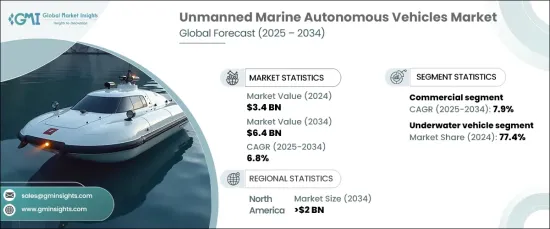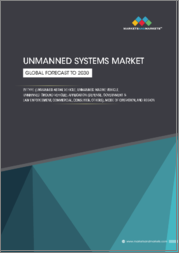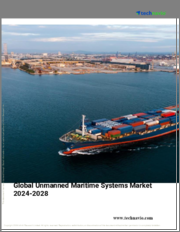
|
시장보고서
상품코드
1665415
무인 해상 자율주행차 시장 기회, 성장 촉진요인, 산업 동향 분석 및 예측(2025-2034년)Unmanned Marine Autonomous Vehicles Market Opportunity, Growth Drivers, Industry Trend Analysis, and Forecast 2025 - 2034 |
||||||
세계의 무인 해상 자율주행차 시장은 2024년 34억 달러로 평가되었습니다. 2025년부터 2034년에 걸쳐 6.8%의 안정적인 CAGR로 성장할 것으로 예측됩니다.
해상 모니터링과 보안 요구 증가가 이 시장 확대에 중요한 역할을 하고 있습니다. 해적행위, 밀수, 영토분쟁 등의 불법행위가 국제해역과 연안해역 모두에서 계속 증가하고 있기 때문에 정부 및 방위기관은 감시, 정찰, 순찰을 위해 UMAV(무인 해상 자율주행차)를 이용하게 되었습니다. 이 차량은 고도의 자율성을 갖추고 있으며, 기존의 인간이 조종하는 선박의 몇 분의 하나의 비용으로 장시간의 운용과 광대한 지역의 커버가 가능합니다.

UMAV는 고해상도 카메라, 적외선 열 카메라, 소나, 위성 통신 시스템 등의 최첨단 기술을 탑재하여 실시간 모니터링 및 데이터 수집을 보장합니다. UMAV는 자율적인 능력을 통해 인적 위험을 줄이고 군사, 상업 해운, 해양 에너지 등 다양한 분야에서 운영 효율성과 효율성을 향상시킵니다. 해양영역인식(MDA) 강화의 추진은 이러한 고도의 감시 시스템 수요를 더욱 높여 시장의 성장에 기여하고 있습니다.
| 시장 범위 | |
|---|---|
| 시작 연도 | 2024년 |
| 예측 연도 | 2025-2034년 |
| 시작 금액 | 34억 달러 |
| 예측 금액 | 64억 달러 |
| CAGR | 6.8% |
자율 내비게이션과 인공지능(AI)의 발전으로 UMAV의 성능이 크게 향상되었습니다. 센서, 레이더, LIDAR, GPS, 관성 내비게이션 시스템을 통합함으로써 이러한 차량은 효율적으로 항해하고 장애물을 피하고 인간의 개입을 최소화하면서 변화하는 환경에 적응할 수 있습니다. 머신러닝과 AI 기술을 통해 UMAV는 경로를 최적화하고 실시간 의사 결정을 내리고 복잡한 작업을 자율적으로 수행할 수 있습니다. 이러한 기술 혁신은 과제인 해상조건 하에서도 정확한 항행을 보장하여 군사, 과학, 상업의 각 용도에 있어서의 신뢰성과 범용성을 높여줍니다. 이러한 기술이 지속적으로 향상됨에 따라, UMAV는 다양한 산업에 있어서 점점 더 중요해지고 있으며, 그 채용은 세계적으로 확산되고 있습니다.
2024년 시장 점유율은 수중 UMAV가 77.4%로 압도적인 기록을 달성했습니다. 이러한 차량은 인프라 검사, 자원 탐사, 환경 모니터링과 같은 복잡한 수중 작업에 특히 필요합니다. 센서, 소나 시스템, 카메라가 장착된 수중 UMAV는 어려운 해양 환경에서 효율적으로 작동합니다. 해상 파이프라인의 검사나 해저 매핑 등 인간의 개입을 거의 필요로 하지 않고 작업을 수행할 수 있기 때문에 석유 및 가스, 방위, 해양조사 등 업계에서 편리하게 이용되고 있습니다. 배터리 기술, 센서의 정확성, 통신 시스템의 지속적인 개발이 상업/방위 양 부문에서의 사용 증가를 더욱 뒷받침하고 있습니다.
상업 부문의 성장이 가장 빠르며 예측 기간의 CAGR은 7.9%를 나타낼 것으로 추정됩니다. UAMAV는 해양 에너지, 해운, 인프라 모니터링 등의 산업에 필수적이 되고 있습니다. 해양 에너지는 장비, 해저 파이프라인 및 풍력 발전소를 검사하는 데 사용되며, 상업 선박은 항로 최적화, 환경 조건 모니터링 및 모니터링에 도움이 됩니다. 또한, 이러한 차량은 최소한의 인적 관여로 해중 매핑과 해저 조사를 용이하게 함으로써 해양 조사와 양식을 지원합니다. 기술 발전은 해양 탐사 및 환경 관리를 위한 보다 효율적이고 비용 효율적인 솔루션을 창출하고 상업 부문을 계속 견인하고 있습니다.
북미의 UMAV 시장은 2034년까지 20억 달러 이상에 달할 것으로 예상되고 있으며, 미국이 그 견인 역할을 하고 있습니다. 방위, 에너지, 환경 분야의 강한 수요가 이 성장을 지원하고 있습니다. 미국 정부의 자율기술 발전에 대한 헌신과 연구 프로젝트에 대한 자금 제공은 시장을 더욱 강화하고 감시 및 대잠수함전과 같은 군사 용도에서의 지속적인 확장을 보장합니다.
목차
제1장 조사 방법과 조사 범위
- 시장 범위와 정의
- 기본 추정과 계산
- 예측 계산
- 데이터 소스
- 1차 데이터
- 2차 데이터
- 유료 소스
- 공개 소스
제2장 주요 요약
제3장 업계 인사이트
- 생태계 분석
- 밸류체인에 영향을 주는 요인
- 이익률 분석
- 방해
- 향후 전망
- 제조업체
- 유통업체
- 공급자의 상황
- 이익률 분석
- 주요 뉴스와 대처
- 규제 상황
- 영향요인
- 성장 촉진요인
- 해상 모니터링 및 보안 솔루션에 대한 수요 증가
- 자율 항행 및 AI 기반 기술의 진보
- 방위 및 해양 탐사 분야에 대한 투자 증가
- 해외 에너지 및 환경 모니터링 용도 확대
- 고급 센서 및 통신 시스템의 통합
- 업계의 잠재적 위험 및 과제
- 높은 운용 비용 및 도입 시 유지보수 과제
- 무인 해상 오퍼레이션에 대한 규제·법적 제약
- 성장 촉진요인
- 성장 가능성 분석
- Porter's Five Forces 분석
- PESTEL 분석
제4장 경쟁 구도
- 서론
- 기업 점유율 분석
- 경쟁 포지셔닝 매트릭스
- 전략 전망 매트릭스
제5장 시장 추계·예측 : 유형별(2021-2034년), 100만 달러
- 주요 동향
- 지상 차량
- 수중 차량
제6장 시장 추계·예측 : 속도별(2021-2034년), 100만 달러
- 주요 동향
- 10노트까지
- 10-30노트
- 30노트 이상
제7장 시장 추계·예측 : 내구성별(2021-2034년), 100만 달러
- 주요 동향
- <100시간 미만
- 100-500시간
- 500-1,000시간
- >1,000시간 이상
제8장 시장 추계·예측 : 솔루션별(2021-2034년), 100만 달러
- 주요 동향
- 추진 시스템
- 통신 시스템
- 페이로드
- 섀시 재료
- 기타 솔루션
제9장 시장 추계·예측 : 최종 용도별(2021-2034년), 100만 달러
- 주요 동향
- 방위
- 연구
- 상업
- 기타
제10장 시장 추계·예측 : 지역별(2021-2034년), 100만 달러
- 주요 동향
- 북미
- 미국
- 캐나다
- 유럽
- 영국
- 독일
- 프랑스
- 이탈리아
- 스페인
- 러시아
- 아시아태평양
- 중국
- 인도
- 일본
- 한국
- 호주
- 라틴아메리카
- 브라질
- 멕시코
- 중동 및 아프리카
- 남아프리카
- 사우디아라비아
- 아랍에미리트(UAE)
제11장 기업 프로파일
- ASV Global
- Atlas Elektronik
- BAE Systems
- Bharat Dynamics Limited(BDL)
- ECA Group
- General Dynamics
- L3Harris Technologies
- Liquid Robotics
- Northrop Grumman
- Ocean Aero Inc.
- Pelorus Naval Systems
- Rafael Advanced Defense Systems
- Saab AB
- Sea Robotics Inc.
- Teledyne Technologies Inc.
- Textron Inc.
- Thales Group
- Unmanned Systems Technology
The Global Unmanned Marine Autonomous Vehicles Market, valued at USD 3.4 billion in 2024, is projected to grow at a steady CAGR of 6.8% from 2025 to 2034. The growing need for maritime surveillance and security plays a crucial role in this market expansion. As incidents of illegal activities such as piracy, smuggling, and territorial conflicts continue to rise in both international and coastal waters, governments and defense agencies are increasingly turning to UMAVs for monitoring, reconnaissance, and patrolling. These vehicles offer a high level of autonomy, enabling them to operate for extended periods and cover vast areas at a fraction of the cost of traditional human-piloted vessels.

UMAVs are equipped with cutting-edge technologies like high-resolution cameras, thermal imaging, sonar, and satellite communication systems, ensuring real-time monitoring and data gathering. With their autonomous capabilities, UMAVs also reduce human risk, improving operational efficiency and effectiveness in multiple sectors, including military, commercial shipping, and offshore energy. The push for enhanced maritime domain awareness (MDA) further fuels the demand for these advanced surveillance systems, contributing to market growth.
| Market Scope | |
|---|---|
| Start Year | 2024 |
| Forecast Year | 2025-2034 |
| Start Value | $3.4 Billion |
| Forecast Value | $6.4 Billion |
| CAGR | 6.8% |
Advances in autonomous navigation and artificial intelligence (AI) are significantly enhancing the performance of UMAVs. The integration of sensors, radar, LIDAR, GPS, and inertial navigation systems enables these vehicles to navigate efficiently, avoid obstacles, and adapt to changing environments with minimal human intervention. Machine learning and AI technologies empower UMAVs to optimize their routes, make real-time decisions, and autonomously carry out complex tasks. These innovations ensure accurate navigation, even in challenging maritime conditions, thus increasing their reliability and versatility across military, scientific, and commercial applications. As these technologies continue to improve, UMAVs are becoming increasingly indispensable for various industries, broadening their adoption globally.
The market for underwater UMAVs dominates with a 77.4% market share in 2024. These vehicles are particularly sought after for complex underwater operations, including infrastructure inspections, resource exploration, and environmental monitoring. Equipped with sensors, sonar systems, and cameras, underwater UMAVs perform efficiently in difficult marine environments. Their ability to carry out tasks such as offshore pipeline inspections and seabed mapping with little human intervention makes them valuable to industries like oil and gas, defense, and marine research. Continued developments in battery technology, sensor accuracy, and communication systems further support their increasing use in both commercial and defense sectors.
The commercial sector is experiencing the fastest growth, with a CAGR of 7.9% over the forecast period. UMAVs are becoming integral to industries such as offshore energy, shipping, and infrastructure monitoring. In offshore energy, they are used to inspect rigs, subsea pipelines, and wind farms, while in commercial shipping, they help optimize routes, monitor environmental conditions, and conduct surveillance. Additionally, these vehicles support marine research and aquaculture by facilitating underwater mapping and seabed surveys with minimal human involvement. Technological advancements continue to drive the commercial sector, creating more efficient and cost-effective solutions for marine exploration and environmental management.
North America UMAV market is expected to exceed USD 2 billion by 2034, with the United States leading the charge. The country's strong demand from the defense, energy, and environmental sectors supports this growth. The U.S. government's commitment to advancing autonomous technology and funding research projects further strengthens the market, ensuring its continued expansion in military applications like surveillance and anti-submarine warfare.
Table of Contents
Chapter 1 Methodology & Scope
- 1.1 Market scope & definitions
- 1.2 Base estimates & calculations
- 1.3 Forecast calculations
- 1.4 Data sources
- 1.4.1 Primary
- 1.4.2 Secondary
- 1.4.2.1 Paid sources
- 1.4.2.2 Public sources
Chapter 2 Executive Summary
- 2.1 Industry synopsis, 2021-2034
Chapter 3 Industry Insights
- 3.1 Industry ecosystem analysis
- 3.1.1 Factor affecting the value chain
- 3.1.2 Profit margin analysis
- 3.1.3 Disruptions
- 3.1.4 Future outlook
- 3.1.5 Manufacturers
- 3.1.6 Distributors
- 3.2 Supplier landscape
- 3.3 Profit margin analysis
- 3.4 Key news & initiatives
- 3.5 Regulatory landscape
- 3.6 Impact forces
- 3.6.1 Growth drivers
- 3.6.1.1 Increasing demand for maritime surveillance and security solutions
- 3.6.1.2 Advancements in autonomous navigation and AI-based technologies
- 3.6.1.3 Rising investments in defense and marine exploration sectors
- 3.6.1.4 Expanding offshore energy and environmental monitoring applications
- 3.6.1.5 Integration of advanced sensors and communication systems
- 3.6.2 Industry pitfalls & challenges
- 3.6.2.1 High operational costs and maintenance challenges of deployment
- 3.6.2.2 Regulatory and legal constraints for unmanned marine operations
- 3.6.1 Growth drivers
- 3.7 Growth potential analysis
- 3.8 Porter’s analysis
- 3.9 PESTEL analysis
Chapter 4 Competitive Landscape, 2024
- 4.1 Introduction
- 4.2 Company market share analysis
- 4.3 Competitive positioning matrix
- 4.4 Strategic outlook matrix
Chapter 5 Market Estimates & Forecast, By Type, 2021-2034 (USD Million)
- 5.1 Key trends
- 5.2 Surface vehicle
- 5.3 Underwater vehicle
Chapter 6 Market Estimates & Forecast, By Speed, 2021-2034 (USD Million)
- 6.1 Key trends
- 6.2 Up to 10 knots
- 6.3 10−30 knots
- 6.4 More than 30 knots
Chapter 7 Market Estimates & Forecast, By Endurance, 2021-2034 (USD Million)
- 7.1 Key trends
- 7.2 <100 hours
- 7.3 100−500 hours
- 7.4 500−1,000 hours
- 7.5 >1,000 hours
Chapter 8 Market Estimates & Forecast, By Solution, 2021-2034 (USD Million)
- 8.1 Key trends
- 8.2 Propulsion system
- 8.3 Communication system
- 8.4 Payload
- 8.5 Chassis material
- 8.6 Other solutions
Chapter 9 Market Estimates & Forecast, By End Use Application, 2021-2034 (USD Million)
- 9.1 Key trends
- 9.2 Defense
- 9.3 Research
- 9.4 Commercial
- 9.5 Others
Chapter 10 Market Estimates & Forecast, By Region, 2021-2034 (USD Million)
- 10.1 Key trends
- 10.2 North America
- 10.2.1 U.S.
- 10.2.2 Canada
- 10.3 Europe
- 10.3.1 UK
- 10.3.2 Germany
- 10.3.3 France
- 10.3.4 Italy
- 10.3.5 Spain
- 10.3.6 Russia
- 10.4 Asia Pacific
- 10.4.1 China
- 10.4.2 India
- 10.4.3 Japan
- 10.4.4 South Korea
- 10.4.5 Australia
- 10.5 Latin America
- 10.5.1 Brazil
- 10.5.2 Mexico
- 10.6 MEA
- 10.6.1 South Africa
- 10.6.2 Saudi Arabia
- 10.6.3 UAE
Chapter 11 Company Profiles
- 11.1 ASV Global
- 11.2 Atlas Elektronik
- 11.3 BAE Systems
- 11.4 Bharat Dynamics Limited (BDL)
- 11.5 ECA Group
- 11.6 General Dynamics
- 11.7 L3Harris Technologies
- 11.8 Liquid Robotics
- 11.9 Northrop Grumman
- 11.10 Ocean Aero Inc.
- 11.11 Pelorus Naval Systems
- 11.12 Rafael Advanced Defense Systems
- 11.13 Saab AB
- 11.14 Sea Robotics Inc.
- 11.15 Teledyne Technologies Inc.
- 11.16 Textron Inc.
- 11.17 Thales Group
- 11.18 Unmanned Systems Technology


















